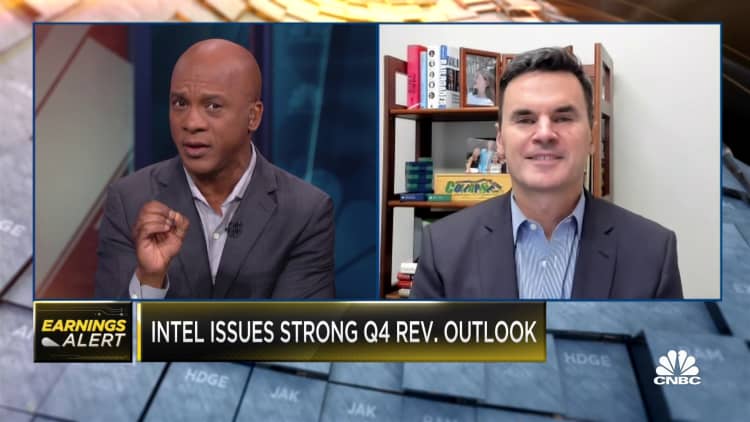
[ad_1]
Signage outside Intel headquarters in Santa Clara, California, on Monday, Jan. 30, 2023.
David Paul Morris | Bloomberg | Getty Images
Intel shares rose about 7% in after-hours trading after the company reported third-quarter earnings on Thursday that beat expectations for profit and sales, even as overall revenue declined.
Here’s how Intel did versus LSEG (formerly Refinitiv) consensus expectations for the quarter ended October 1:
- Earnings per share: 41 cents, adjusted, versus 22 cents expected
- Revenue: $14.16 billion, versus $13.53 billion expected
For the fourth quarter, Intel expects earnings of 23 cents per share, adjusted, on revenue of $14.6 billion and $15.6 billion, versus LSEG expectations of 32 cents per share on $14.31 billion in sales.
Intel posted GAAP net income of $297 million, or 7 cents per share, versus net income of $1.02 billion, or 25 cents per share in the same quarter last year. Intel’s gross margin for the quarter was 45.8%, which is flat year-over-year.
Revenue fell 8% from $15.33 billion a year ago, the seventh consecutive quarter of declining sales. However, it told investors on Thursday that it expects revenue to grow again in the current quarter.
Intel CEO Pat Gelsinger told analysts on a call the company would cut costs by about $3 billion this year. CFO David Zinsner said that Intel’s earnings per share this quarter benefited from the company controlling expenses, with operating expenses declining 15% from a year ago. Intel said it has 120,300 employees, down from 131,500 last year.
Here’s how Intel’s business units performed:
- Sales in Intel’s Client Computing group, including laptop and PC processor shipments, were down 3% to $7.9 billion.
- Intel’s Data Center and AI division, which offers server chips, saw sales decline 10% to $3.8 billion. Intel said it was seeing competitive pressure and a smaller overall market for server processors.
- Mobileye, a publicly-traded Intel subsidiary for self-driving car parts, was a bright spot, growing 18% to $530 million in sales.
- Intel foundry services, the company’s nascent chip manufacturing business, remains a small part of Intel with $311 million in revenue, but it grew nearly 300% on an annual basis. Intel said that a major customer had committed to using some of Intel’s capacity, and had paid a pre-payment.
- Intel’s network and edge division, which sells networking parts, reported sales down 32% to $1.5 billion.

Earlier this month, Intel said it would treat its programmable chip unit as a standalone business, and would seek to list it on public markets in two years. It’s currently part of Intel’s Data Center and AI group, and saw sales decline sequentially during the quarter.
“As we discussed earlier this month, after a period of strong growth and tight supply, the FPGA business is entering a period of inventory burn,” Zinsner said.
Intel told investors that it believed that its chips will be useful for artificial intelligence, particularly to run models on local devices, instead of the cloud. Gelsinger acknowledged that some server customers were moving investment away from Intel’s central processors to AI chips like those made by Nvidia.
“While the industry has seen some wallet share shifts between CPUs and accelerators over the last several quarters as well as some inventory burn in the server market, we see signs of normalization as we enter Q4,” Gelsinger said.
Nvidia and AMD are reportedly working on Arm-based chips to compete with Intel in the PC market. Gelsinger said that historically Arm chips didn’t gain a lot of traction in the market, and that Intel sees the potential to manufacture Arm PC chips as an opportunity.
“Arm and Windows client alternatives, generally they’ve been relegated to pretty insignificant roles in the PC business,” Gelsinger said. “We take all competition seriously. But I think with history as our guide here, we don’t see these as potentially being all that significant overall.”
Intel said that it remains on track to catch up with Taiwan Semiconductor Manufacturing Company’s chipmaking technology by 2025, a plan the company calls “five nodes in four years.”
“While many thought our ambitions were a bit audacious when we began our ‘five nodes in four years’ journey roughly two and-a-half years ago, we have increasing line of sight towards achieving our goal,” Gelsinger said.
[ad_2]
Source link